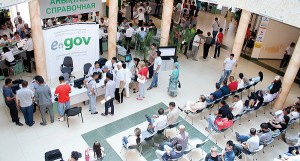ASTANA – Among the most successful reforms the Kazakh government has implemented in the last decade, experts often name the establishment of an extensive network of Centres for Servicing the Population (CSP).
The centres, widely known in Kazakhstan by their Russian acronym, TSON, were set up in 2007 with the aim of assisting citizens in providing government services under one roof under the so-called “one window” principle. The aim was to eliminate unnecessary bureaucracy and remove administrative barriers to accessing services by the population.
The main benefits of CSPs are to ensure equal access for everybody and allow the population to access any necessary documents from various state bodies in one place, as well as to limit direct contact between officials responsible for issuing documents and applicants.
In 2011, in order to improve the efficiency of CSPs, the centres were completely modernised and merged with the infrastructure of e-government. As a result, customer service times were reduced, a system of employee performance evaluation introduced and an opportunity to book visits ahead of time through the e-government portal was created.
In addition, during the recent modernisation of CSPs, the government focused on making them accessible for people with disabilities. Each centre is now equipped with special ramps and call buttons.
At the moment, 260 CSPs operate across the nation and provide 160 public services. (In 2011, there were 59 public services available.) Through a state programme directed to ensure the availability of public services to the general public, including people in remote settlements, 70 mobile CSPs were organised through the country.
The new-format CSPs have improved the quality of public services delivery and created tools for monitoring and assessing its quality. One of these tools is the Situation Analysis Centre, with online video-monitoring of 161 CSPs. The Situation Analysis Centre allows monitors to respond promptly to deficiencies in the process of work, including the build-up of queues.
As Kazakhstan’s population and its average income rise, the number of car owners has increased, and new Special Centres for Servicing the Population have been opened. These Special CSPs provide services for obtaining a driver’s license, registering vehicles and issuing license plates.
The Special CSPs, with their many automated services, have cut the wait time for getting a driver’s license from six hours to two, and vehicle registration certificates can be obtained within one hour. Now, applicants no longer need to fill in forms at the centre, bring copies of documents to confirm their places of residence, collect certificates and so on. Instead, operators independently find the right data in the relevant databases based on the electronic data available from Personal Identification Numbers on the citizen’s ID card.
On New Year’s Eve, employees of the CSPs of Astana and Almaty organised an unusual event. In the halls of the centres, professional painters drew portraits and caricatures of waiting customers.
“I did not expect to meet an artist in the CSP, but I immediately asked him to paint my portrait. This is a very desirable gift for the New Year, and my turn has not come yet. In my view, it is a great initiative of the staff,” said Arai Rakhmetova, a visitor to a CSP in Astana.
On Jan. 13, another creative idea was implemented at one of the CSPs in Astana, where students from the International Information Technology University created a new robot called Arman. Arman was created to act as a public servant, said the financial and commercial director of the university, Medet Turgambayev. The robot acts as an electronic terminal for the issuance of certificates. It can also provide consultations to customers on CSP services.
According to Turgambayev, the robot was created at the request of the Ministry of Justice of Kazakhstan. The developers embedded a touch screen, video camera and a laser for reading bar codes on identification cards. In addition, Arman greets visitors and invites them to assess the quality of services rendered.
In 2013, the Arman robot’s developers created a robot which they called Sholpan, which then began to work at CSPs in Kazakhstan.



